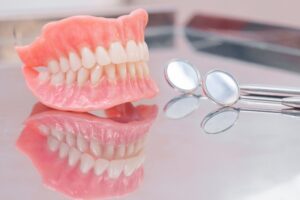
Let’s say you’re a schoolteacher. The last thing you want to happen in a room full of kids is for your dentures to fall out in the middle of a lesson. The next thing you know, you’re the subject of a viral TikTok post. Ideally, your prosthetic teeth should be adjusted regularly to maintain a comfortable, firm grip, but denture adhesive could be the short-term solution for this issue and others. Read on to learn the tell-tale signs that it could be useful to you and how to apply it.
Reasons to Use Adhesive
Adhesive for your dentures might do you some good if:
- Your dentures don’t hold in place as you’d hoped: If you find that your device slips and slides a little too much for your comfort, or impedes routine functions like smiling, eating, and talking, adhesive may be a good suggestion.
- You experience dry mouth: Saliva keeps dentures in place for most people, but dry mouth can be a problem for older people, those taking medication, or people with a medical condition. Without optimal saliva production, it can be difficult for your dentures to hold onto your gums.
- You’re in a forward-facing profession: Teachers, musicians, and public speakers could all benefit from a little security being “on stage” due to their jobs.
- You recently had teeth extracted and are new to dentures: It can take around 10 months for your bone to heal after having teeth removed, so there will be an adjustment period before your new dentures fit right.
How to Apply Adhesive to Your Dentures
The process will vary a bit depending on if you’re using cream, powder, or strips, but regardless of the application, before you begin, you should thoroughly clean your dentures with a soft toothbrush and warm water to remove any food particles or debris. Be sure to dry them well, too.
- Applying Strips
- Make sure your hands are completely dry before handling the strip.
- Peel the strip open and lay it in the middle of the denture.
- Swish warm water in your mouth, then place the denture on your gums.
- Firmly press your dentures down in place.
- Applying Powder
- Wet the denture with warm water.
- Sprinkle the powder along the underside of the denture and shake off any loose powder.
- Press your dentures onto your gums and hold them for a few seconds.
- Applying Cream
- Using a cotton swab, apply a very thin layer of cream around the edges of your dentures to form a seal. Don’t apply it to the middle of the denture as it will squish out when you put your dentures in.
- Place the denture on your gums and press down.
How to Remove Adhesive from Your Restoration
First, you’ll want to remove the dentures from your arches. Fill your mouth with warm water or mouthwash and swish to loosen the denture from your gums. Spit and use a soft toothbrush to clean your gums, using a circular motion.
After your mouth is clean, you can use the same toothbrush to clean your dentures. Run warm water on the underside of the denture and gently brush until the adhesive is removed. If you’re using strips, remove them from the prosthesis and then brush.
If you don’t want to have to use denture adhesive each day, consider consulting your dentist about implant dentures.
Don’t let your dentures hinder your ability to enjoy everyday life – use adhesive if necessary to restore function and confidence!
About the Practice
The experts at DentaCrafters PLLC can meet all your denture needs! We offer high-quality, customized options, including partial, full, and implant dentures. Need a different kind of service? Our staff can handle an array of needs, whether it’s a routine cleaning or an emergency that needs immediate attention. Contact us online or call our Falls Church office at (703) 241-5775.
